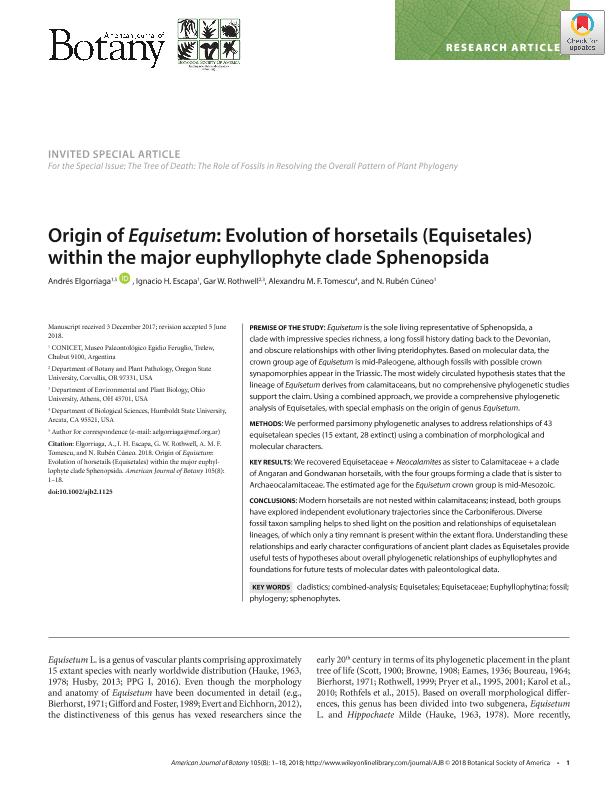Mostrar el registro sencillo del ítem
dc.contributor.author
Elgorriaga, Andres

dc.contributor.author
Escapa, Ignacio Hernán

dc.contributor.author
Rothwell, Gar W.
dc.contributor.author
Tomescu, Alexandru M. F.
dc.contributor.author
Cúneo, Néstor Rubén

dc.date.available
2022-11-11T13:23:29Z
dc.date.issued
2018-08
dc.identifier.citation
Elgorriaga, Andres; Escapa, Ignacio Hernán; Rothwell, Gar W.; Tomescu, Alexandru M. F.; Cúneo, Néstor Rubén; Origin of Equisetum: Evolution of horsetails (Equisetales) within the major euphyllophyte clade Sphenopsida; Botanical Society of America; American Journal of Botany; 105; 8; 8-2018; 1286-1303
dc.identifier.issn
0002-9122
dc.identifier.uri
http://hdl.handle.net/11336/177436
dc.description.abstract
Premise of the Study: Equisetum is the sole living representative of Sphenopsida, a clade with impressive species richness, a long fossil history dating back to the Devonian, and obscure relationships with other living pteridophytes. Based on molecular data, the crown group age of Equisetum is mid-Paleogene, although fossils with possible crown synapomorphies appear in the Triassic. The most widely circulated hypothesis states that the lineage of Equisetum derives from calamitaceans, but no comprehensive phylogenetic studies support the claim. Using a combined approach, we provide a comprehensive phylogenetic analysis of Equisetales, with special emphasis on the origin of genus Equisetum. Methods: We performed parsimony phylogenetic analyses to address relationships of 43 equisetalean species (15 extant, 28 extinct) using a combination of morphological and molecular characters. Key Results: We recovered Equisetaceae + Neocalamites as sister to Calamitaceae + a clade of Angaran and Gondwanan horsetails, with the four groups forming a clade that is sister to Archaeocalamitaceae. The estimated age for the Equisetum crown group is mid-Mesozoic. Conclusions: Modern horsetails are not nested within calamitaceans; instead, both groups have explored independent evolutionary trajectories since the Carboniferous. Diverse fossil taxon sampling helps to shed light on the position and relationships of equisetalean lineages, of which only a tiny remnant is present within the extant flora. Understanding these relationships and early character configurations of ancient plant clades as Equisetales provide useful tests of hypotheses about overall phylogenetic relationships of euphyllophytes and foundations for future tests of molecular dates with paleontological data.
dc.format
application/pdf
dc.language.iso
eng
dc.publisher
Botanical Society of America

dc.rights
info:eu-repo/semantics/openAccess
dc.rights.uri
https://creativecommons.org/licenses/by-nc-sa/2.5/ar/
dc.subject
CLADISTICS
dc.subject
COMBINED-ANALYSIS
dc.subject
EQUISETACEAE
dc.subject
EQUISETALES
dc.subject
EUPHYLLOPHYTINA
dc.subject
FOSSIL
dc.subject
PHYLOGENY
dc.subject
SPHENOPHYTES
dc.subject.classification
Paleontología

dc.subject.classification
Ciencias de la Tierra y relacionadas con el Medio Ambiente

dc.subject.classification
CIENCIAS NATURALES Y EXACTAS

dc.title
Origin of Equisetum: Evolution of horsetails (Equisetales) within the major euphyllophyte clade Sphenopsida
dc.type
info:eu-repo/semantics/article
dc.type
info:ar-repo/semantics/artículo
dc.type
info:eu-repo/semantics/publishedVersion
dc.date.updated
2022-11-10T15:21:52Z
dc.journal.volume
105
dc.journal.number
8
dc.journal.pagination
1286-1303
dc.journal.pais
Estados Unidos

dc.description.fil
Fil: Elgorriaga, Andres. Museo Paleontológico Egidio Feruglio; Argentina. Consejo Nacional de Investigaciones Científicas y Técnicas; Argentina
dc.description.fil
Fil: Escapa, Ignacio Hernán. Museo Paleontológico Egidio Feruglio; Argentina. Consejo Nacional de Investigaciones Científicas y Técnicas; Argentina
dc.description.fil
Fil: Rothwell, Gar W.. State University of Oregon; Estados Unidos. Ohio University; Estados Unidos
dc.description.fil
Fil: Tomescu, Alexandru M. F.. Humboldt State University; Estados Unidos
dc.description.fil
Fil: Cúneo, Néstor Rubén. Consejo Nacional de Investigaciones Científicas y Técnicas; Argentina. Museo Paleontológico Egidio Feruglio; Argentina
dc.journal.title
American Journal of Botany

dc.relation.alternativeid
info:eu-repo/semantics/altIdentifier/url/https://onlinelibrary.wiley.com/doi/abs/10.1002/ajb2.1125
dc.relation.alternativeid
info:eu-repo/semantics/altIdentifier/doi/http://dx.doi.org/10.1002/ajb2.1125
Archivos asociados
